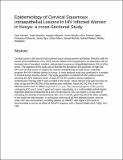Epidemiology of Cervical Squamous Intraepithelial Lesions in HIV Infected Women in Kenya: A Cross-Sectional Study
View/
Publication Date
2015-03Type
Otherviews
downloads
Metadata
Show full item recordCitation
Memiah P, Makokha V, Mbuthia W, Kiiru GW, Agbor S, Odhiambo F, Ojoo S, Mbizo J, Muhula S, Mahasi G, Biadgilign S. Epidemiology of Cervical Squamous Intraepithelial Lesions in HIV Infected Women in Kenya: a cross-Sectional Study. Afr J Reprod Health. 2015 Mar;19(1):133-9. PMID: 26103703.
Abstract/
Cervical cancer is the second most common cancer among women worldwide. Infection with the human immunodeficiency virus (HIV) and its related immunosuppression are associated with an increased risk of prevalent, incident, and persistent squamous intraepithelial lesions (SILs) of the cervix. The objective of the study was to describe the prevalence and predictors of high-risk HPV and cervical cancer to support the need for strengthening cervical cancer screening programs for HIV infected women in Kenya. A cross sectional study was conducted in a hospital in Central Kenya, Kiambu district. The study population constituted of HIV positive women attending the ART treatment clinic. A total of 715 HIV positive women initiated on Antiretroviral Therapy (ART) were enrolled in this study. About 359 (52.1%) were less than 40 years of age and 644 (90.3%) of the patients were widowed. About 642 (92.6%) of the HIV infected women were in follow-up period of ≥ 1 year. The outcome/prognosis of the patients undergoing ICC was 3 cured, 5 good and 4 poor respectively. In a multivariable ordinal logistic regression analysis showed that for a one-unit decrease of CD4, we expect 1.23 log odds of increasing the severity of cervical cancer (B=1.23, P<0.015), given that all of the other variables in the model are held constant. In conclusion screening of all HIV infected women, who are under HIV care and treatment, enrolling patients on HAART with higher CD4 counts is recommended to see the net effect of HAART response.
Further Details
Abstract
Publisher
Mason PublishingCollections
- General - GEN [367]

